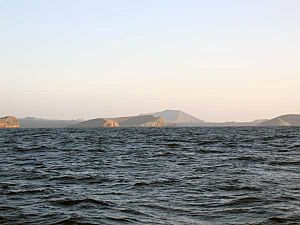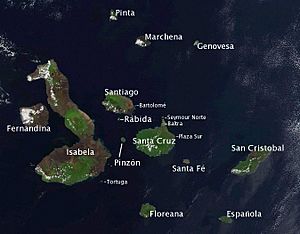Action off James Island facts for kids
Quick facts for kids Action off James Island |
|||||||
|---|---|---|---|---|---|---|---|
| Part of the War of 1812 | |||||||
 James Island from the south in 2008. |
|||||||
|
|||||||
| Belligerents | |||||||
| Commanders and leaders | |||||||
| None | |||||||
| Strength | |||||||
| 1 sloop | 3 whaling brigs | ||||||
| Casualties and losses | |||||||
| none | 2 killed 6 wounded 75 captured 3 brigs captured |
||||||
|
|||||||
The Action off James Island was a small but important naval battle during the War of 1812. In May 1813, an American warship captured three British whaling ships. This happened near James Island in the Galapagos Archipelago, far out in the Pacific Ocean. Only one of the British ships fought back. This event was one of the few naval fights that took place in the Pacific during the war.
Background to the Battle
About a year before this battle, Captain David Porter sailed his ship, the USS Essex, around Cape Horn. His mission was to attack British whaling ships. These ships were sailing off the coast of South America. This type of attack is called commerce raiding.
After capturing several ships, Captain Porter took a British whaling ship called the Georgiana. It was a 280-ton sloop, which is a type of sailing ship. The Georgiana originally had two guns. But Captain Porter added more weapons. He gave it six 18-pounder cannons, four swivel guns, and six blunderbusses.
Porter put Lieutenant John Downes in charge of the Georgiana. Downes had a crew of 42 navy sailors and six volunteers. These volunteers were American sailors who had recently been captured. Captain Porter told Lieutenant Downes to bother the British ships near James Island. This island is part of the Galapagos chain.
The Battle Begins
Lieutenant Downes left the main ship, the Essex, on May 12. He sailed south towards James Island. On the afternoon of May 28, the crew of the Georgiana saw sails in the distance. These sails belonged to two British ships. They were the 270-ton whaling ship Catharine and the 220-ton whaling ship Rose.
Downes ordered his crew to chase the ships. He raised the Union Jack, which is the British flag. This was a trick to make the whalers think the Georgiana was a friendly British ship. When the American ship got close enough, they lowered small boats. Sailors quickly boarded and captured both the Catharine and the Rose. The British captains later said they didn't realize they were being attacked until the Americans were already on their decks.
The two captured ships had a total of 16 guns, eight on each ship. They also had 50 sailors, who became prisoners. Just as the Rose and Catherine were captured, a third ship appeared. It was the Hector, another whaling ship. The Hector had 11 guns and a crew of 25 men.
The Georgiana quickly went after the Hector. After a chase, the sun began to set before the American ship was close enough to fire. In the dark, the Georgiana fired a warning shot. The Hector fired back, but their shots missed. The Americans then began to attack the British ship. They fired shots that ripped off the Hector's main mast and most of its ropes and sails.
The Georgiana fired four more rounds of shots. When the Hector's firing seemed to weaken, the Georgiana moved in to board. Just as the Americans got close, the British lowered their flag. This meant they surrendered. So, the Americans boarded the ship without any more fighting.
Two British sailors were killed in the battle, and six others were seriously wounded. All of the British shots missed the Georgiana. The Americans reported no damage to their ship and no one was hurt.
After the Battle
The Americans took 75 prisoners in total. Since there were fewer than 50 American sailors to guard them, Lieutenant Downes made a plan. He removed the guns from the Rose and put all the prisoners on that ship. They were then released on parole. This means they promised not to fight again until they were officially exchanged. They were ordered to sail to Saint Helena.
The Georgiana returned to the Essex on June 24. The Essex was anchored near Tumbez, Peru. On the same day as the battle, Captain David Porter captured two more whaling ships. These were the Montezuma (with 18 guns) and the Greenwich (with 10 guns). Captain Porter now commanded nine armed ships in the Pacific Ocean.
Lieutenant Downes was promoted on November 28, 1813. He was recognized for his bravery in many battles against the British and local people of Nuka Hiva.
Later, the British managed to recapture all three whaling ships. They were returned to their work of whaling. The British warship HMS Barrosa recaptured the Georgiana in the Atlantic Ocean on November 28, 1813. It was then sent to Bermuda.
Note
Only the Rose was sailing with a special document called a letter of marque. This document allowed Captain Mark Munro to engage in offensive actions, meaning he could attack other ships. The other two British whalers, the Catherine and the Hector, were only allowed to use their weapons for self-defense.


